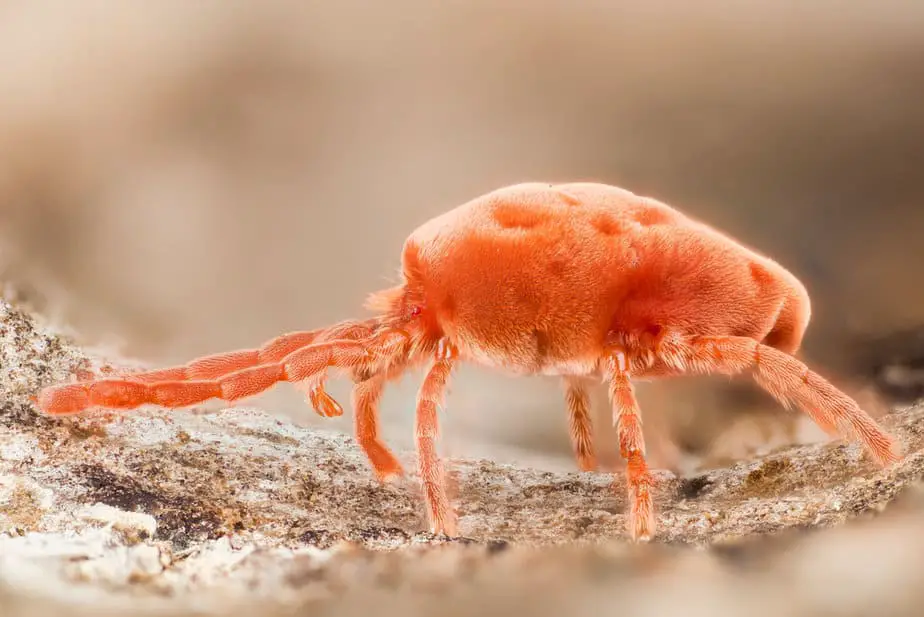
Like many other reptiles, leopard geckos can be affected by mites that live on their skin, causing various health issues. Mites feed on your gecko’s blood and can lead to irritation, itching, and even anemia in severe cases.
Understanding and identifying mite infestations will enable you to care for your gecko properly.
We’ll discuss the symptoms and consequences of mite infestations for your leopard gecko. Then we’ll give you some tips for prevention and treatment.
Signs of Mites on a Leopard Gecko
Mites infestations in leopard geckos can be distressing for you and your pet.
Recognizing the signs early can help ensure proper treatment and relief for your gecko.
Leopard geckos experience pain from mite bites. They may lie in their water dish to drown the mites as a response to the discomfort.
Another sign to watch for is a change in your gecko’s skin appearance.
The skin can become coarse, and you might notice frequent issues with shedding or dysecdysis.
Mites can also cause irritation, itching, and even anemia in severe cases.
Some clinical signs that may be observed in your reptile include:
- Loss of appetite
- Inflamed or infected skin
- Itchiness
- Restlessness
Keep a close eye on your gecko’s behavior and appearance to promptly address potential mite infestations.
If you suspect a mite infestation, don’t hesitate to consult a vet for appropriate treatment options.
Common Mites Affecting Leopard Geckos
Snake mites (Ophionyssus natricis) and lizard mites (Hirstiella spp) will live around your gecko’s eyes and skin folds.
These parasites can transmit harmful bacteria and viruses to your pet, so it’s crucial to address the issue immediately.
While treating a mite infestation can be a challenging task, here are some steps you can follow:
- Inspect your gecko’s habitat regularly for any signs of mites.
- Maintain a clean environment for your gecko, cleaning the enclosure on a routine basis.
- Consult your veterinarian for appropriate anti-mite treatments and follow their advice for application.
Preventing Mite Infestations
In this section, you’ll learn about proper habitat maintenance and quarantining new reptiles. Both of these are important factors in preventing mite infestations.
Proper Habitat Maintenance
Regularly cleaning and disinfecting your leopard gecko’s habitat is crucial.
Replace the substrate with fresh material, such as paper towels, to make mites more visible and prevent them from burrowing.
Ensure the temperature and humidity levels are within the recommended range.
Inspect your gecko’s food and water dishes frequently, cleaning them as needed.
Remember to monitor any other cage accessories, such as hides, for mite activity. If you spot mites, act quickly to treat the infestation and prevent it from spreading.
Quarantine for New Reptiles
When introducing new reptiles to your collection, it’s crucial to quarantine them before mixing them with leopard geckos.
This helps prevent the potential spread of mites and any other health issues.
Set up a separate enclosure for incoming reptiles, maintaining a comfortable, clean environment.
Closely observe new geckos for any signs of mite infestations and visible or unusual health issues.
Quarantine periods typically last for 30 days or more.
Treating Mite Infestations
Mite infestations can be very uncomfortable for your leopard gecko. Fortunately, different treatments are available to help eliminate them.
In this section, we’ll explore natural remedies and chemical treatments to assist you in selecting the best option for your pet.
Natural Remedies
One natural method to consider is bathing your gecko in warm water with a small amount of dish soap added.
This can help kill the mites and remove any eggs on their skin. Just remember to rinse your gecko thoroughly afterward to remove any soap residue.
Another option is to use food-grade diatomaceous earth (DE) powder. This will effectively treat mites and other insects with exoskeletons.
Sprinkle the DE powder around your gecko’s habitat, focusing on areas where mites may be present.
Regularly change your gecko’s bedding to reduce the infestation and prevent mites from returning.
Chemical Treatments
If natural remedies do not provide satisfactory results, your vet might prescribe an anti-parasitic medication.
These medications should be used with caution due to concerns about toxicity. Always follow your vet’s dosage instructions and monitor your gecko closely for any adverse side effects.
It’s also crucial to clean and sterilize your leopard geckos habitat.
Replace any easily replaceable items, such as the substrate, to ensure the mite infestation does not recur.
Aftercare and Monitoring
Your leopard gecko might need some aftercare if they were treated for mites. Let’s discuss ways to ensure full recovery and prevent future infestations.
Ensuring Full Recovery
After treating your leopard gecko for mites, give them time to heal. It’s important to monitor your gecko’s behavior and overall health.
Keep their enclosure clean and sanitized. This helps create a comfortable environment for recovery.
You should also provide a balanced diet with adequate nutrients to help your gecko regain strength.
Consult your veterinarian for recommended dietary adjustments or supplements.
Preventing Future Infestations
Preventing mites is crucial for the well-being of your leopard gecko. Follow these simple steps to reduce the risk of future infestations:
- Inspect and clean your gecko’s enclosure.
- Perform a thorough clean-up of the enclosure. Disinfect surfaces, change substrate, and clean all decorations.
- Maintain optimum temperature and humidity levels in the enclosure, as recommended by RSPCA. This helps reduce stress on your gecko and keeps its immune system strong.
- Quarantine any newly acquired reptiles for at least 30 days before introducing them to your leopard gecko enclosure. This helps minimize the spread of any potential parasites.
By following these steps, you’ll be on your way to ensuring your leopard gecko stays healthy and mite-free.
